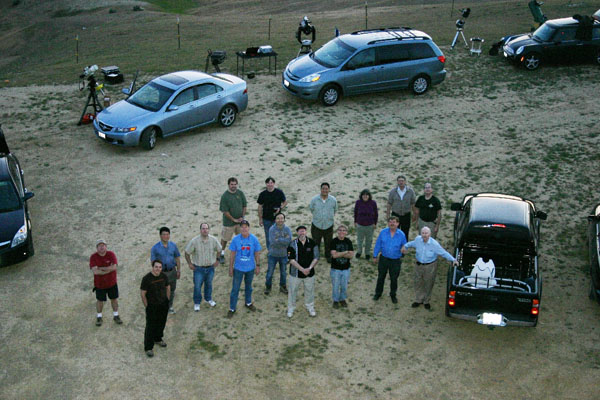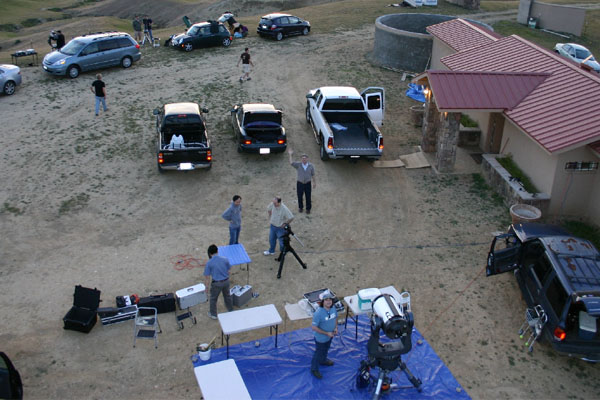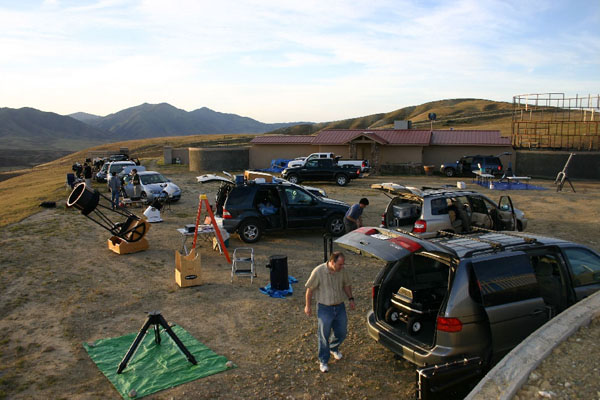I would like to thank Dr. Lee Hoglan, Dr. Bob Caton, and all those who have been involved with the D.A.R.C. Observatory, for their generous invitation. The site of the D.A.R.C. Observatory is a pleasant two hour drive away from San Jose, which makes it an extremely convenient location. It is truly dark, and offers great horizons, especially toward the south. By midnight, after the high clouds had dissipated, the sky turned “sugary”. The light domes from Fresno, Hollister and Los Banos were relatively inconspicuous. The seeing was decent, although a bit soft at times. Among the highlights of the night, I was able to log about 20 new H400 objects, saw Omega Centauri (NGC 5139) pretty easily in my 9×63 binocular (I spotted it naked eye once I knew where to look) Peter Natscher also shared views through his 24″ F/3.7 Starmaster telescope:
- M101, reminiscent of Rogelio’s recent photograph (see TAC archive)
- NGC 4565, absolutely superb
- A galaxy cluster in Leo (we counted about a dozen faint galaxies in one eyepiece)
- A superb Arp galaxy (I can’t remember which one) with jaw-dropping intricate details
- A globular cluster (M3 I believe) using a binoviewer
Below are some photos of the event, followed by my log for that most excellent night. All objects were observed using my 12″ F/5 Dobsonionan telescope. Cheers!
Location: D.A.R.C. Observatory [Elevation 1400ft]
Telescope: Meade Lightbridge 12″ F/5
Eyepieces used:
- Televue Panoptic 27mm (56x - 1.2° TFOV)
- Televue Nagler 16mm type 5 (95x - 52′ TFOV)
- Televue Nagler 9mm type 6 (169x - 29′ TFOV)
- Televue Nagler 5mm type 6 (305x - 16′ TFOV)
(All times are PST)
NGC 2787 GX UMa 09h20m13.0s +69°10’01 11.6 mag 10:50p
Round, gradually brighter toward the center, with a non stellar core surrounded by a very faint halo. Faint star 1′ SE, even fainter one 1′ W-SW.
NGC 2976 GX UMa 09h48m05.1s +67°52’35 10.8 mag 11:05p
Elongated 3×1 NW-SE. Fairly uniform, no central condensation visible. Fairly bright superimposed star at the SW edge of the halo. Slightly fainter star (mag. 14.1) just beyond the NW edge of the halo.
NGC 2985 GX UMa 09h51m16.9s +72°14’17 11.2 mag 11:15p
Round, with an almost stellar core surrounded by a faint halo. A star of similar apparent magnitude as the nucleus of this galaxy can be found 1′ E.
NGC 3034 (M82, the Cigar Galaxy) GX UMa 09h56m42.9s +69°38’15 9.0 mag 11:25p
At low power (56x and 95x), this galaxy appears very bright and very elongated SW-NE. It looks like a cigar or a spindle. At higher magnification (169x), many details start to appear. A large dark lane almost splits the galaxy in half. Other dark and bright patches can be seen throughout.
NGC 3077 GX UMa 10h04m08.7s +68°41’26 10.6 mag 11:35p
Very slightly elongated NE-SW. Fairly large core surrounded by a faint uniform halo.
NGC 5457 (M101) GX UMa 14h03m35.0s +54°17’56 8.4 mag 11:40p
Seen through Peter Natscher’s 24″ F/3.7 Starmaster using a Televue Ethos 17mm eyepiece. The view was absolutely incredible! It was reminiscent of photographs I’ve seen of this galaxy. The spiral arms were superbly defined, and many bright knots (HII regions maybe?) were easily popping out here and there.
NGC 2742 GX UMa 09h08m20.1s +60°26’40 12.1 mag 11:55p
Elongated 2×1 E-W. Fairly uniform, with only a weak central condensation.
NGC 2768 GX UMa 09h12m23.5s +60°00’05 10.8 mag 12:00a
Bright, elongated 3×1 E-W with a fairly bright non stellar core.
NGC 2950 GX UMa 09h43m18.5s +58°48’37 11.9 mag 12:10a
Bright, almost stellar core. Faint halo, elongated 2×1 NW-SE.
NGC 3079 GX UMa 10h02m39.1s +55°38’12 11.4 mag 12:15a
Very elongated almost N-S, slightly curved and assymetrical. Faint superimposed star at the northern end.
NGC 3310 GX UMa 10h39m23.4s +53°27’17 11.2 mag 12:25a
Round, small and fairly bright, with a relatively large core.
NGC 2681 GX UMa 08h54m14.9s +51°16’48 11.2 mag 12:30a
Very bright, almost stellar core surrounded by a faint round halo.
NGC 2841 GX UMa 09h22m43.4s +50°56’17 10.0 mag 12:45a
Elongated 4×1 NW-SE. Fairbly bright elongated core with a stellar nucleus. Pretty faint superimposed star at the NW end.
NGC 3184 GX UMa 10h18m52.7s +41°22’39 10.4 mag 01:00a
At low power, this galaxy appears as a uniform disk. At higher power, with a bit of concentration, a faint and stellar nucleus appears embedded inside a very weak and slightly elongated core. The halo shows hints of spiral structure.
NGC 3198 GX UMa 10h20m31.5s +45°30’10 10.9 mag 01:05a
Pretty faint. Elongated 3×1 NE-SW. Fairly uniform with a very weak core and some very subtle mottling.
NGC 4027 GX Crv 12h00m00.5s -19°19’14 11.6 mag 01:35a
Overall pretty faint with a weak core. Northern portion of the halo shows a spiral arm, confirming my impression on Mar 24.
NGC 3166 GX Sex 10h14m16.3s +03°22’34 11.5 mag 01:50a
Small, roundish, with a fairly bright almost stellar core. This galaxy forms an interesting couple with NGC 3169, located only 7′ E.
NGC 3169 GX Sex 10h14m45.4s +03°25’04 11.3 mag 01:50a
Small, roundish, with a fairly bright almost stellar core. This galaxy forms an interesting couple with NGC 3166, located only 7′ W.
NGC 3556 (M108) GX UMa 11h12m06.7s +55°37’22 10.7 mag 01:15a
Fairly uniform. Elongated 5×1 E-W. Superimposed star right in the center - could be confused with the galaxy nucleus. Some mottling was easily detected.
NGC 3726 GX UMa 11h33m54.2s +46°58’35 10.7 mag 02:25a
At low power (95x), this galaxy appears uniform, elongated 2×1 almost N-S. At higher power (169x), a faint stellar nucleus appears, along with some hints of a spiral structure.
NGC 3877 GX UMa 11h46m40.1s +47°26’28 11.8 mag 02:30a
Elongated 5×1 NE-SW with a weak core and a faint stellar nucleus.
NGC 3893 GX UMa 11h49m10.6s +48°39’22 10.8 mag 02:35a
Small, roundish, fairly bright, with a large core. Fairly bright superimposed star about 1′ NW. Very faint superimposed star less than 1′ S. Halo does not seem perfectly uniform.
Quality dissertation writing: on demand wide c | Vi är beredda på att uppfylla vilka önskemål som helst | coupon code shoes


